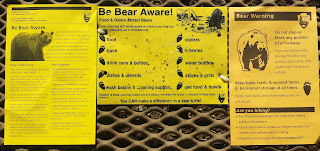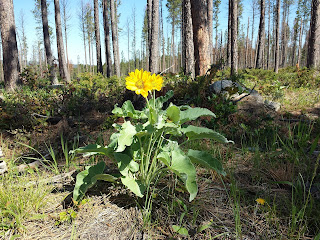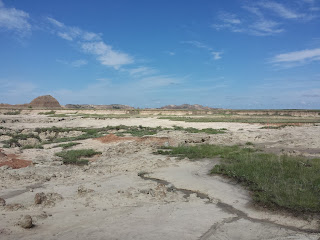 |
| Even the waves here are dangerous |
So far however, our closest encounters with big scary wildlife came two weeks ago in the Grand Tetons National Park. The day was clear, and after drying things out from the previous evenings thunderstorm we set off on a 7 mile hike around Jenny Lake with a few short side trails planned up to Hidden Falls and Inspiration Point. More than half way through the hike all was going as as planned, although really, you can't plan on views, and nature being that gorgeous.
 |
| 3 Bear Warnings are Better Than One |
The trails we took however were well traveled and the Rangers (all whom carried holstered bear spray) thought we'd be okay without spray. We hiked most of the way around Jenny Lake to String Lake when we were stopped by a Ranger. He informed us that the trail was closed due to "bear activity." Apparently this bear had been hanging around the nearby picnic area and was becoming dangerous, the Park Service was attempting to trap and remove him. We could see the giant bear trap up on the hill, didn't get to see the bear. However, we did have to turn around and hike all the way back around the Lake. We ended up walking a bit more than 12 miles all-in-all.
 Our next encounter with dangerous wildlife occurred that same evening. After returning to the campsite we had dinner and were just settling in for the night when an elk wandered into the campsite. A big bull elk. He didn't really pay us much attention, just ate the grasses, stripped leaves off the various bushes, and looked around once in a while. It wasn't until another camper attempted to shoot a close-up photo and the elk lowered his giant antlers in his direction that anyone became alarmed. But that was enough of a threat for all of us to back off and realize that his being comfortable with us didn't make him any less dangerous.
Our next encounter with dangerous wildlife occurred that same evening. After returning to the campsite we had dinner and were just settling in for the night when an elk wandered into the campsite. A big bull elk. He didn't really pay us much attention, just ate the grasses, stripped leaves off the various bushes, and looked around once in a while. It wasn't until another camper attempted to shoot a close-up photo and the elk lowered his giant antlers in his direction that anyone became alarmed. But that was enough of a threat for all of us to back off and realize that his being comfortable with us didn't make him any less dangerous. Tomorrow we head up into the mountains of Southern Oregon to do our first week of serious hiking. Experiences with these animals reminds us that while all the places we've been, and scenery we've seen, isn't just for our benefit. There are lots of other folks out here, and there is still the need to be safe. If we meet Big Foot on the trail, we'll be sure and say hi.
























